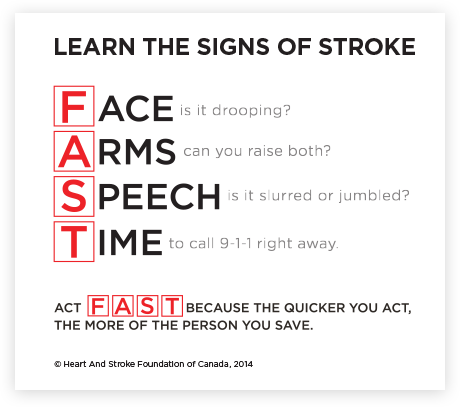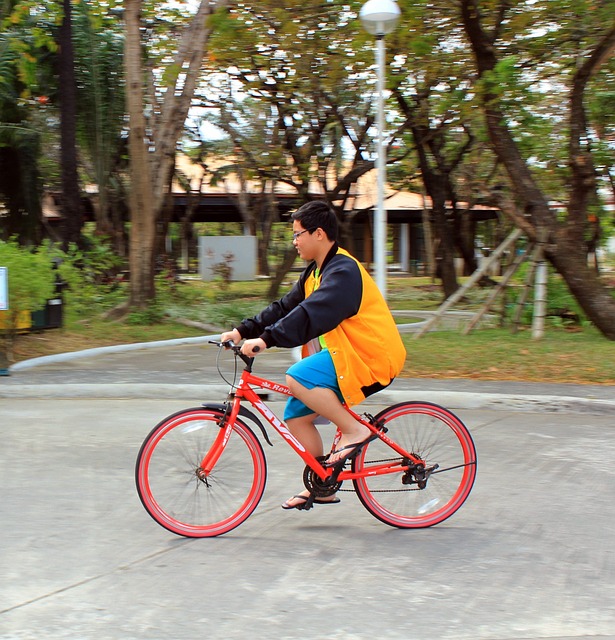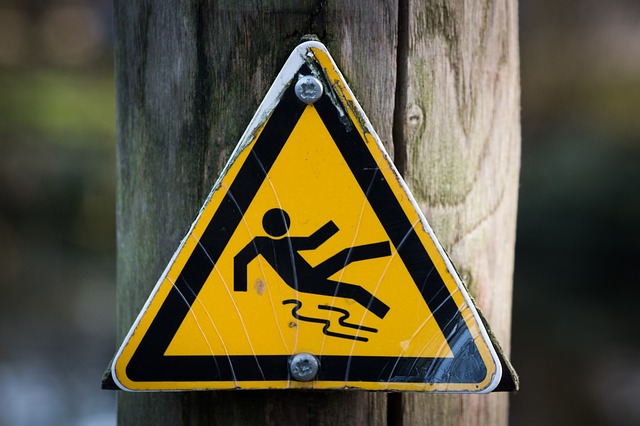We talk a lot about concussions on our blog. Why? Concussions are a serious brain injury that should not be left untreated and are one of the main reasons to seek the services of an Occupational Therapist. Sports-related concussions are estimated at 30 000 per year in Canada with many occurring in popular contact sports such as hockey, football, and soccer. It is important for coaches, athletes and parents to recognize the signs of a concussion and follow strict guidelines if a head injury occurs. The following from Parachute Canada provides “Concussion Guidelines for the Athlete.” Check it out and be sure you are aware. If you suffer a head injury make sure you see a doctor and always remember “when it doubt, sit it out!”

Stroke Awareness: Think F.A.S.T.
When experiencing a stroke quick action can help to save a life and prevent long term damage, but the signs often go unrecognized. The following from The Heart and Stroke Foundation is an excellent interactive video which allows you to experience a stroke from the eyes of both the witness and the victim. Check out the video and other great tips to help you recognize the signs of a stroke and remember to think F.A.S.T.
The Heart and Stroke Foundation: Learn the Signs of Stroke by Experiencing One
photo courtesy of the Heart and Stroke Foundation
Reduce The Risk of Stroke by Changing Your Diet
There are many risk factors that can lead to a stroke, and many, including high cholesterol and obesity, are tied to diet. The following article from Reader’s Digest discusses a recent study showing how eating a typical “Western Diet” can increase the risk of stroke and provides suggestions on changing your diet to reduce your risk.
Concussion Basics
The following video by Dr. Mike Evans gives a great overview of concussions that is simply and easy to understand. It provides parents and children with vital information about how concussions occur, the symptoms of a concussion, and some guidelines for recovery.
Remember, a concussion is a serious injury and requires treatment and rest to ensure the brain recovers properly. Ensure you speak to your Family Doctor and consult an Occupational Therapist if you or your child has suffered a head injury.

So I Guess Your Kid Doesn’t Wear A Seat Belt Either?
I get very confused when I see children riding bikes without helmets. Over the last many years the safety benefits of a helmet for biking, skiing, skateboarding, ice skating (and many other sports) has been well studied. Research shows that helmets can be extremely effective in preventing head injuries and ¾ of all cycling fatalities are the result of head trauma. You don’t even have to hit a car or tree to sustain a head injury – the ground or even your handlebars are often enough.
The laws in Ontario are clear: since October 1, 1995 anyone under the age of 18 is required to ride a helmet on a road or sidewalk (http://www.toronto.ca/cycling/safety/helmet/helmet_law.htm). Based on an increasing number of adult cycling deaths by head injury, it is likely that this law will soon be extended to adults as it is in other provinces.
So, considering the laws and the well-publicised risks, why are children (including young children) still seen riding bikes without helmets?
As adults, I recognize that we were not raised to wear helmets. Adopting this practice has been difficult as we find it unnatural, maybe uncomfortable, and probably uncool. However, most of us likely wear seatbelts when in a vehicle. Why? BECAUSE WE WERE RAISED THAT WAY. Seatbelt laws in Ontario were passed in 1976 and so many of us were raised in the era of this as mandatory. Many of us probably don’t even have to think about our seatbelt anymore as it is part of our regular “get-in-the-car” routine and we feel naked and exposed without it. We need to apply the same concept of “normal” to our children regarding helmets.
There are two main reasons why children need to wear helmets:
1. They are safe and have been shown to save lives and reduce disability.
2. IT IS THE LAW.
As a parent, by not requiring that your child wear a helmet on their bike you are not only putting them at risk, but are also teaching them that laws don’t matter. And I am not talking about the diligent parents whose children leave the house with a helmet on, to later have this on their handlebars or undone on their head. I am mostly talking about the young kids in my neighbourhood who are out on their bikes without helmets, often under the supervision of their parents, and are thus not being taught that helmets are law, mandatory, and safe.
I am going to hazard a guess that no parent would put their child in a car without a seat-belt. Heck, child seats are also law and until a certain age these are five point and offer more protection than the adult restraint. So, for the same reasons you put your child in a seatbelt (protection and law) you need to ensure they are wearing a helmet for biking (skating, skiing, skateboarding). And lead by example – get a helmet for yourself and model the appropriate behavior. And be firm: no helmet should equal no bike. No discussion
Brain Injury: Are You Aware?
Did you know there are more than 50 000 brain injuries each year in Canada? Are you aware that after suffering one brain injury, you are at three times greater risk for a second brain injury and eight times greater for other bodily injuries? June is Brain Injury Awareness month and with the help of the Brain Injury Society of Toronto (BIST) and their areyouaware.ca campaign we are helping to share facts and create awareness.
Please visit areyouaware.ca for more facts, resources and personal stories and help us spread the word about brain injury this June.
Concussion Recovery
Concussions are serious and it is vital that anyone who has suffered this type of brain injury seek help to ensure proper recovery. In this episode of OT-V we discuss the symptoms of post-concussion syndrome (PCS) and how an Occupational Therapist can help you recover.
Check out more helpful videos in our OT-V series.

An Ounce of Prevention…
Julie Entwistle, MBA, BHSc (OT), BSc (Health / Gerontology)
“An ounce of prevention is worth a pound of cure.” Benjamin Franklin
In recognition of Brain Injury Awareness month, I thought it would be fitting to start at the very beginning. PREVENTION. Really, it is the best medicine. For now, let’s forget about the symptoms of brain injury and its’ impact on work, home, school, and quality of life. Let’s not talk about how it is assessed and treated. Instead, let’s focus on trying to stop it from happening in the first place.
But even before that, we need to know what we are dealing with. It is well known that brain Injury is the leading cause of death and disability worldwide. In Canada, Traumatic Brain Injury (TBI) is more common than breast cancer, spinal cord injury, HIV/AIDS, and multiple sclerosis (MS) combined. There are approximately 18,000 TBI hospitalizations annually. In the province of Ontario, 25% of the two million people diagnosed with a neurological condition have suffered from a TBI. In 2000-2001 brain injuries accounted for $151.7-million in direct costs to Canadians (1).
By way of distribution, TBI is most common in children (0-19) at 30%, followed by seniors (60+) at 29%. In kids, falls are the most common cause followed by motor vehicle accidents and then sports. In adults, motor vehicle accidents cause the most TBI’s, and in seniors the causes include falls (76%) followed by car accidents (2).
Knowing the causes helps to look at how we can engage in preventative strategies. As an occupational therapist with a background in health promotion, a parent of four, and athlete, here are my thoughts:
Falls
Kids fall all the time, so how can we prevent that? Well, there is a difference between a child falling when walking, running or jumping, versus falling from, say, a shopping cart, off of a playground structure, or from a tree they tried to climb. Falls from bikes, skateboards and scooters are going to happen – and a helmet can mean the difference between a head injury and not. The bottom line is that falls in kids are best prevented by proper adult supervision. Yes, it is that simple.
In seniors, falls take on a different form. They are not from carefree or reckless behavior, but often happen when someone is just trying to go about their day by having a shower, coming down the stairs, or taking a leisurely walk. Seniors need to be attuned to the physical, balance and vision changes they are experiencing as they age, and need to consider the importance of anti-slip mats in the bathroom, removing scatter mats, installing grab bars or railings, and the benefits of a walking stick or cane when outdoors. Seniors need to engage in regular exercise and activity to maintain bone density, mobility and intact balance. They have to be very careful when living with pets or when trying to negotiate places that are cluttered or dark. Awareness of declining abilities is the first key to addressing these properly such that a prevention plan can be developed that will ultimately improve safety and reduce the risks. Note that the services of an occupational therapist can be pivotal in creating this safety plan.
Check out our OT-V episode “Fall Prevention” for more helpful information.
Motor Vehicle Accidents
Like falls, despite our best intentions, these can and do happen. The issue here is trying to minimize the risk and optimize the outcome. Safe drivers are attentive, undistracted, and alert. They travel at safe speeds, approach intersections with caution, stop behind the line, pass when appropriate, and recognize that rushing to get somewhere on time is useless if it means you never get there at all. Safe drivers don’t text or hold a phone to their ear, don’t eat a hamburger and steer with their knees, and don’t drive when tired. If you are one of these drivers you are going to increase your chances of avoiding a collision, and lower your chances of being the cause. Unfortunately, however, not everyone is a safe driver. So, all the rest of us can do is wear our seat belt, buy a car with a good safety rating, make sure everyone in the car is buckled properly, make sure the headrest is at a proper height, put loose belongings in the trunk (I know of a child who got a head injury from a flying jar of pickles that escaped the grocery bag during a collision), and follow the rules for child seats.
Sports
I am an avid athlete and have pretty much played or tried every sport. There are very few sports I dislike and I honestly feel that sports can be the most positive and influential outlet for young people, and one of the most engaging and social outlets for adults. The issue is that sports seem to be becoming more and more competitive, kids and adults are getting bigger and stronger, and the culture of some sports has changed from friendly competition to all-out war. Preventing head injury in sport can include outfitting your kids with proper equipment (many hockey parents spend more on a stick than a helmet), ensuring they are playing at their level, monitoring the coaching influence and team culture to make sure this is appropriate, and my favorite is from the book “The Secrets of Successful Families” and includes that the only job of a parent in organized sport is to “shut up and cheer”. No parent should be on the sidelines encouraging reckless, mean or harmful behavior. The results can be devastating. And if you are concerned about your child’s risk of head injury in sport, know that there are many other sports that reduce the risk but are equally as challenging, competitive, fun and have the same physical, cognitive and developmental benefits.
So, let’s start our recognition of Brain Injury Awareness Month by practicing prevention. It does not have to be easier said than done.
Canada’s First Alzheimer’s Health Club
Providing care for an aging or ill loved one is a difficult task. A recent study from the Mental Health Commission of Canada found that of the 5.5 million Canadian adults acting as caregivers, approximately 17% reported caregiver related stress. With the aging population and dementia and Alzheimer’s numbers rising, it is more important than ever for caregivers to ensure that while they are providing the best for their loved ones, they are also caring for themselves. A new facility in Markham Ontario has been launched to do just that. Memory and Company is a private health club with upscale amenities to provide those with Alzheimer’s and related dementias a safe place to be cared for, stay social and remain active while primary caregivers work or enjoy some much needed respite. Check out more about Memory and Company in this recent CTV news piece.
photo care of memoryandcompany.com
Trust Your Intuition
We all have that gut feeling from time to time—the one that tells us to be wary of certain situations or on the other hand to jump in with both feet! Do you trust it? New research tells us we should. Check out the following article from Medial Daily discussing the science behind our gut feelings and why intuition should be an important part of your decision-making process.
Medical Daily: Your Gut Feeling Is Way More Than Just A Feeling– The Science Of Intuition
